Today we are taking a quick look at the CyberPower CP1500PFCRMU UPS. This is a 2U UPS with a 1500VA/1000W Capacity. It has eight total rear-facing outlets and was $335 when we purchased it recently as a Project TinyMiniMicro/ STH Mini PC UPS. We just wanted to show off this unit since we know our readers need to buy these types of units from time-to-time. This one saw challenges when we initially received it, so we wanted to show that as well.
CyberPower CP1500PFCRM2U External Hardware Overview
The unit is 2U in height and is 10.5 inches deep. It weighs about 27 pounds or 12 kilograms. The main body of the unit is plastic, but the built-in rackmount ears are metal.
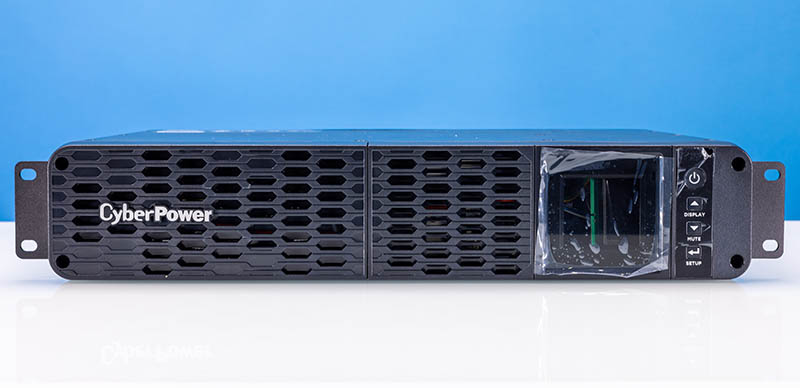
Our unit arrived damaged in shipping, and the front LCD panel was not aligned in the slot. This was an easy fix and did not seem to affect the general functionality of the unit, however, the buttons were not aligned preventing us from turning the unit on. Here is a closer look at the way our front panel popped out as it arrived.
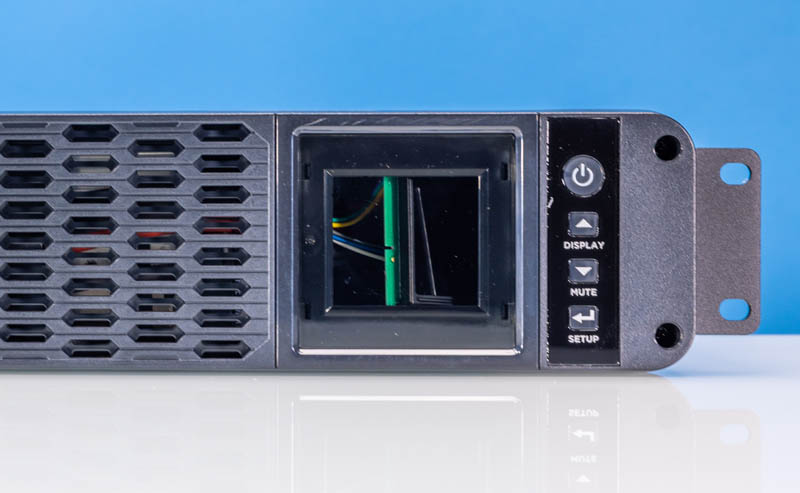
The back of the unit has eight NEMA 5-15R outlets, all of which are surge protected and have battery backup. Two of the outlets are spaced out to allow for larger plugs or transformers. There is a USB port for management, and an option to purchase an add-in-card for SNMP/HTTP remote monitoring.
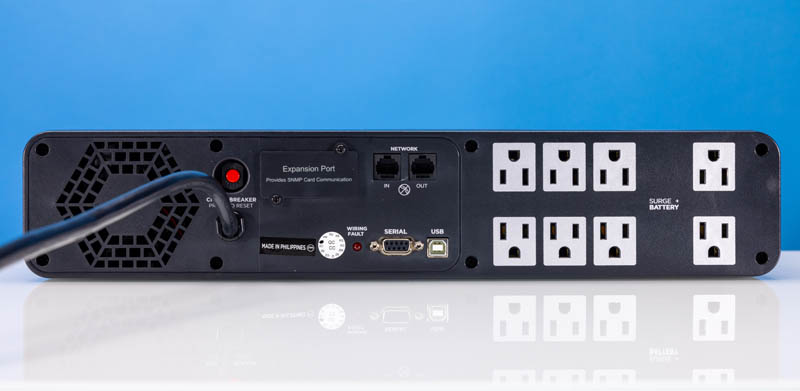
The bottom of the unit is basic with screw holes.
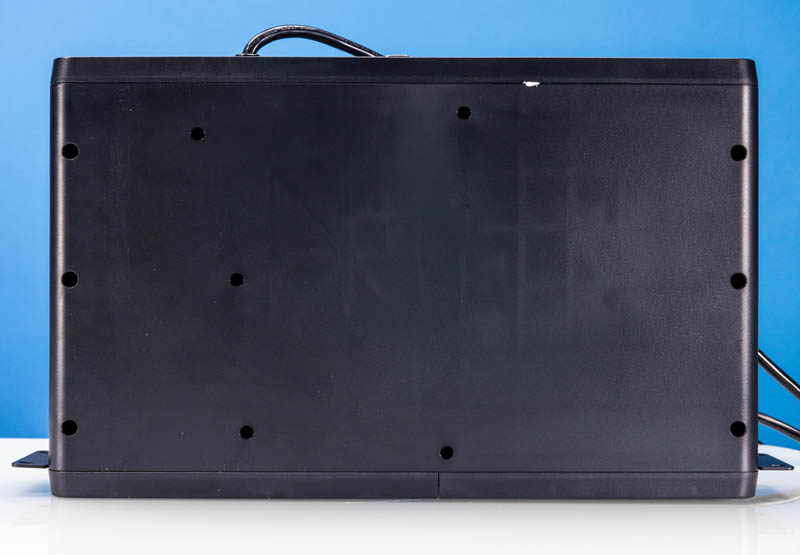
The plug is a standard NEMA 5-15P right angle plug at a 45 degree offset, and the cable is 6ft long. Here you can see that we already popped the screen back in place.
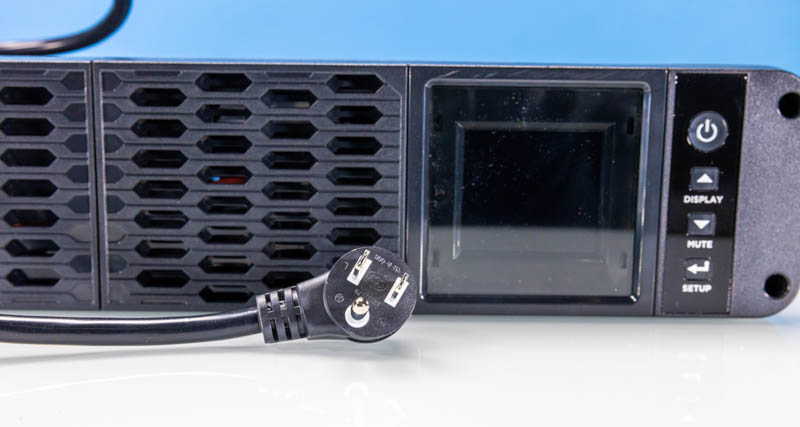
Next, let us get to the internal hardware overview.
CyberPower CP1500PFCRM2U Internal Hardware Overview
As with other power supplies, we have no specific comments on the internals, but we know people like seeing the inside.
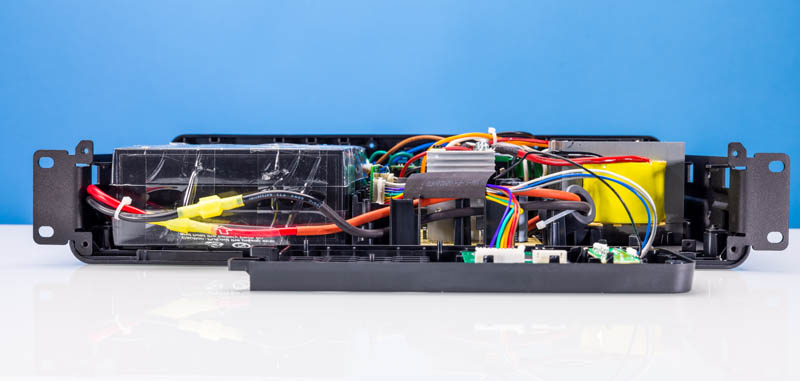
The batteries are two user-replaceable 12V/9Ah Lead-Acid batteries. CyberPower estimates the runtime at full load to be 3.1 minutes and 10.2 minutes at half load. These are designed to be just big enough to let devices shut down on power failure, and are not designed to keep devices online through extended power outages.
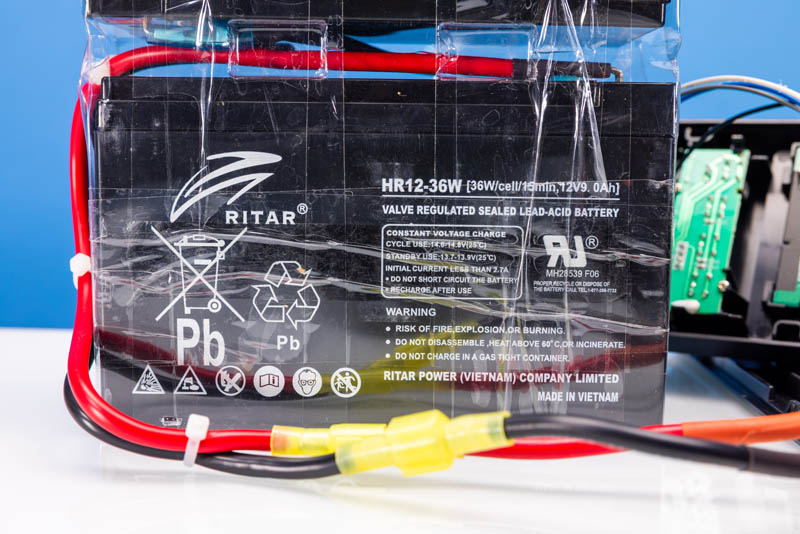
This is a close up of the front panel assembly with both the LCD screen and the buttons.
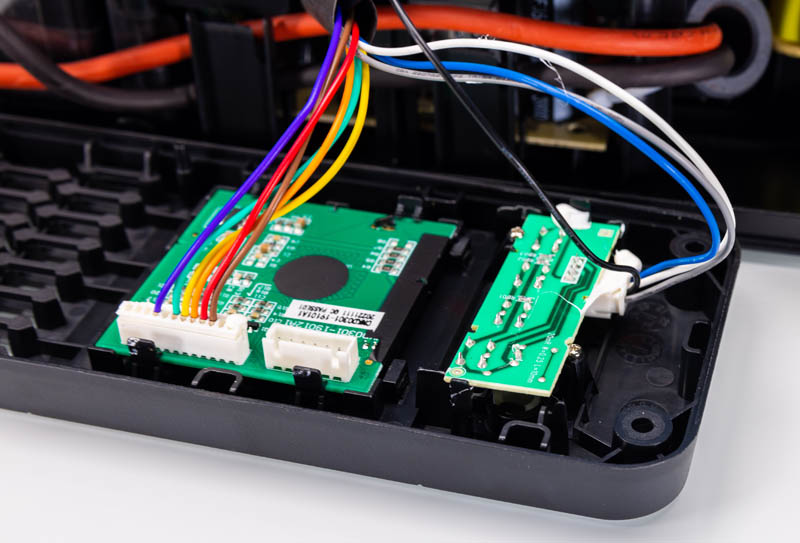
The front panel button assembly arrived out of position, which made the buttons non-functional. This was a fairly easy fix that just required unscrewing the screw and re-seating the board.
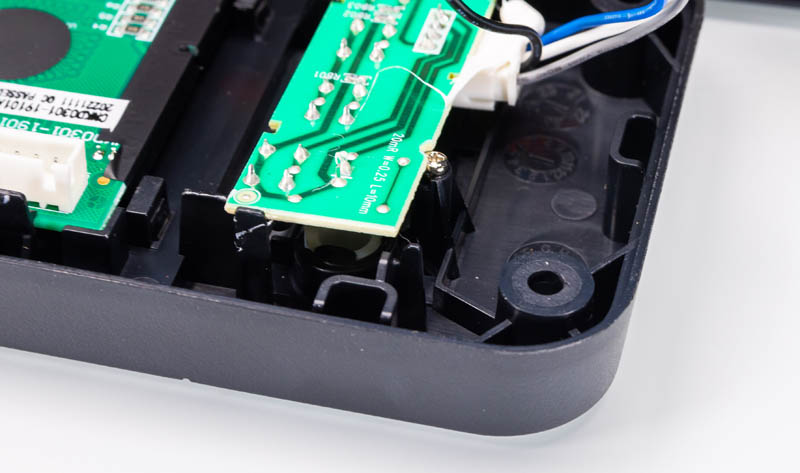
Here is an internal view of the entire UPS with the LCD screen panel off.
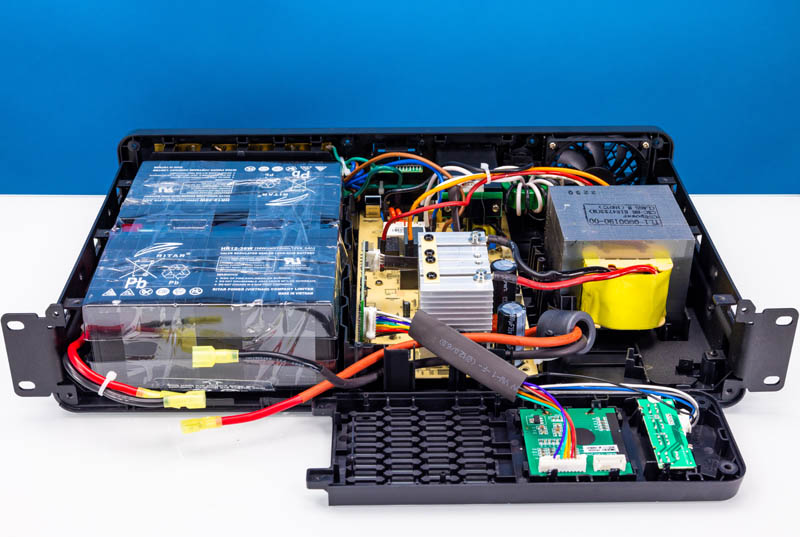
This a picture of the right side of the unit, behind the display.
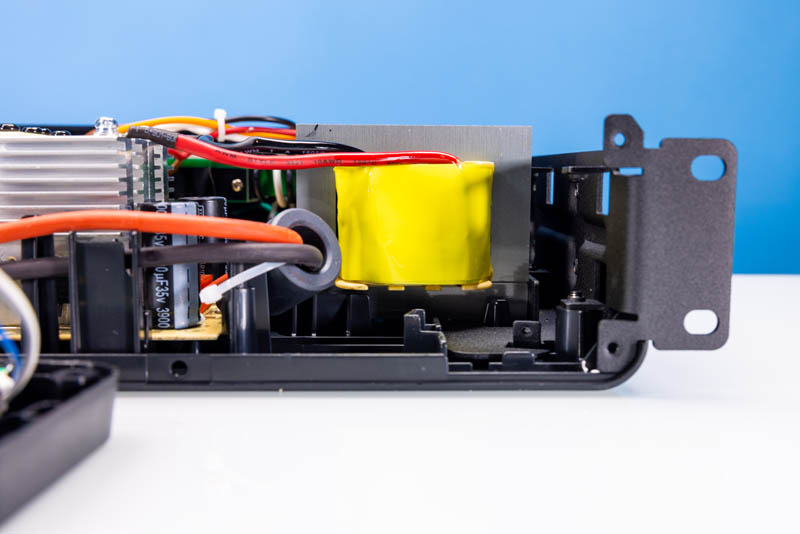
This is a picture of the center of the internals.
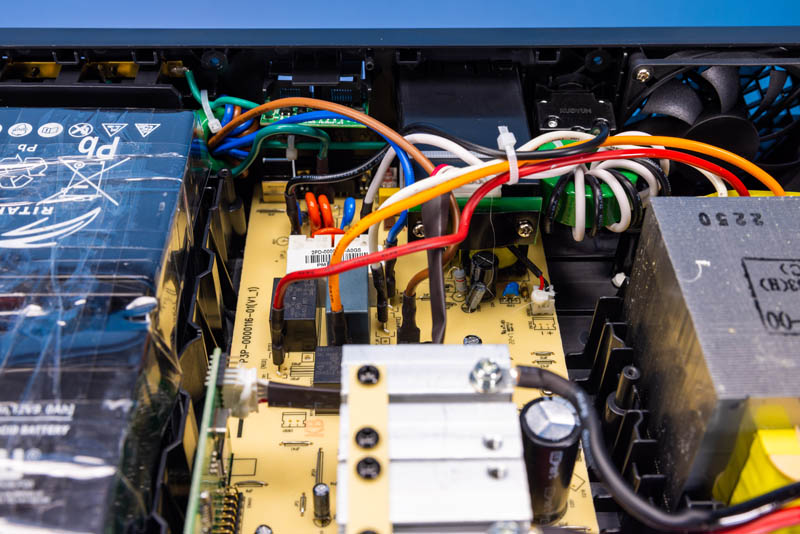
While it was an easy fix, the fact that the packaging and internal assembly was not built to survive an Amazon delivery without damage means there is opportunity to do better. The box was not damaged, so we were surprised to see the LCD panel out of place.
Software
The Cyberpower CP1500PFCRM2U is compatible with the free PowerPanel Business 4 Windows software from Cyberpower. Without the add-in card, only USB functionality is available so it may be inconvenient to access.
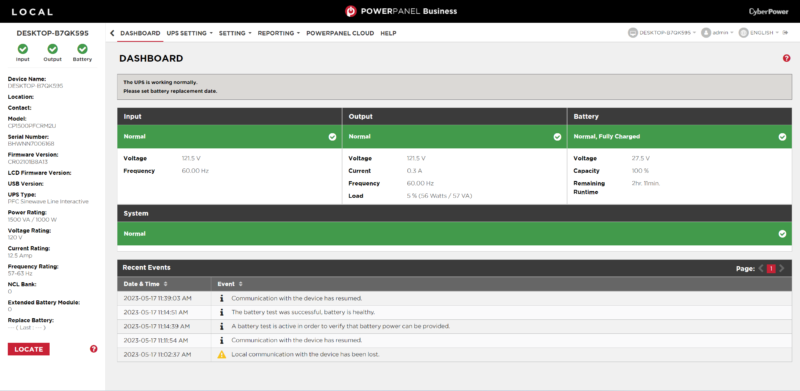
Upper and Lower voltage bounds can be set within the software, along with notifications for low battery or battery replacement.
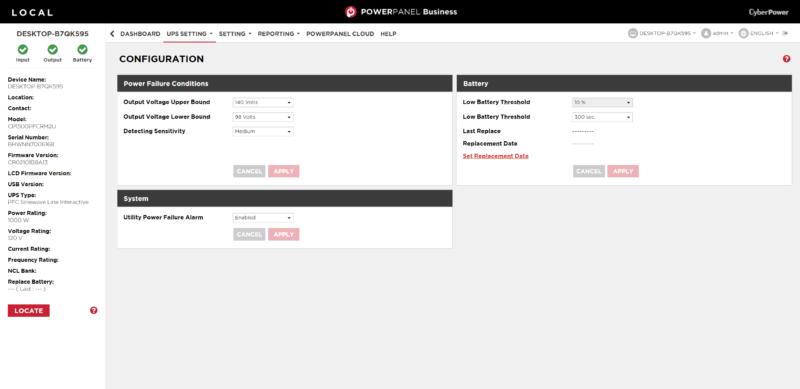
The UPS can send a shutdown request to connected computers to prevent data loss in the event of a prolonged power outage.
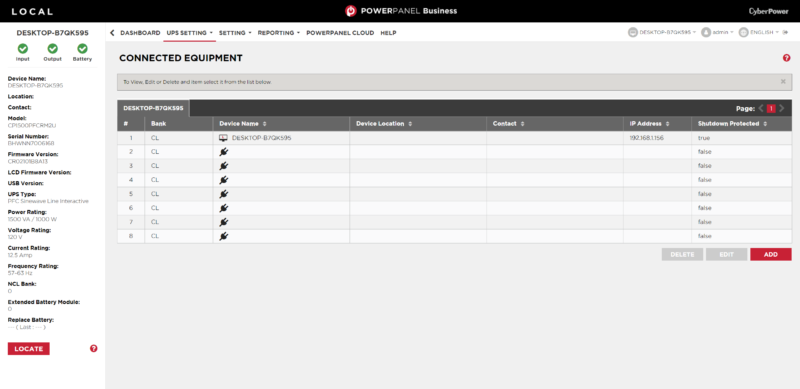
This is fairly standard functionality for this class of device.
Final Words
UPS units are essential for server use to ensure critical systems can shut down properly. With eight outlets, this will probably work for small racks and light day-to-day usage.
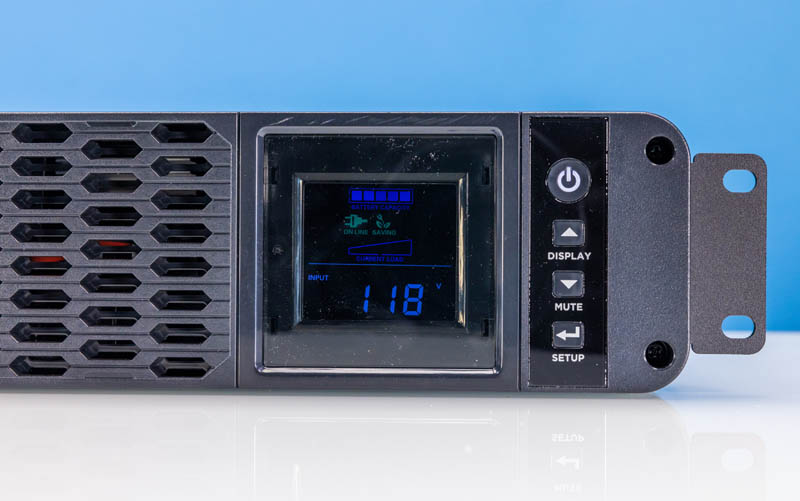
This is a great option for users that require 8 NEMA 5-15 outlets and a battery backup for all of them. Users that require other outlets or voltages may have to search for other options.

If you do not require a battery backup, then check out our reviews for rack-mounted surge protectors, like the CyberPower CPS1215RMS and the Tripp-Lite ISOBAR12ULTRA. We also looked at a higher-end UPS in the Eaton 5P 1U Lithium Ion Rack Battery Unit Review 5P1500R-L.
Pricing and Where to Buy
Here is an Amazon Affiliate link for the latest pricing.

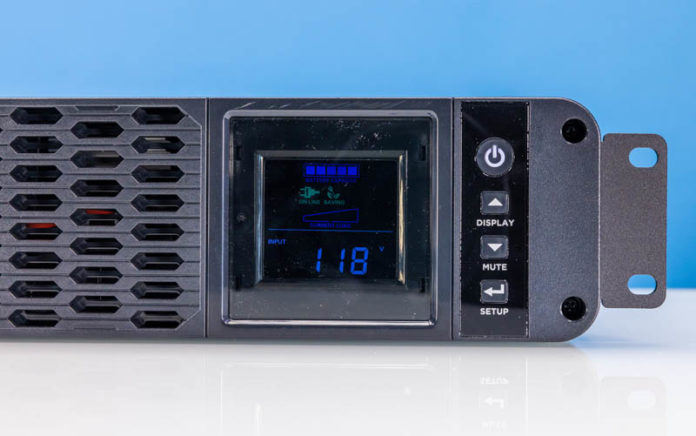
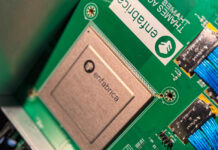


Does it work with upsd/NUT?
The add-in-card for SNMP/HTTP remote monitoring costs as much as the UPS itself!
An interesting solution. 10.5 inch depth makes it difficult to make and remove connections, since many will prefer to mount this at the bottom of a full depth rack. But for a small or network rack this a good potential solution.
@Y0s; there is the presumably-useless-by-design ‘cloud’ monitoring card (RCCARD100) which they manage to sell for ~$65 rather than ~$225; for reasons I can only assume have nothing whatsoever to do with BoM costs; but yeah; while the MSRP is even worse it’s crazy what the management cards cost.
I assume that it’s a great market segmentation/price discrimination item; since it seems to be a UPS vendor convention rather than just something you see on high end models for cost insensitive and conservative customers or on really low end ones that play shell games in order to still make some money while offering the lowest possible advertised price; but that doesn’t make it any less obnoxious that some lightweight application processor on a proprietary expansion card will run you more than a new, name brand, 2x10GbE card for a real computer.
I’m surprised they have a hefty transformer in them when most UPSes now seem to be favouring cheaper transformerless designs, making them much lighter.
It is surprising the monitoring cards are so expensive, when you can get Ethernet-enabled microcontrollers for a few dollars that could do the same job.
If ServeTheHome are going to run this UPS, it would be great to have a follow up article in three and five years’ time, to tell us how the batteries are going. APC units are renowned for cooking their batteries due to overcharging, so even an APC UPS that has hardly run its inverter will still require new batteries after 3-5 years. You can test this by trying to run the inverter at various loads – as the batteries deteriorate they can no longer provide the initial inrush current to start the inverter at higher loads and the whole thing shuts off. After a while it can barely manage to run a small light bulb so you have to replace the batteries – their capacity might still be ok, but they can’t deliver that initial burst of current to get the inverter going. It would be interesting to know whether other brands pay more attention to better managing their batteries to avoid this problem.
@Malv,
You also just described CyberPower batteries. IME APC batteries may initially last a little longer. I just had a bunch of CyberPower batteries drop to the ~12V mark and they may work for 5 seconds, or they may not work for .1 seconds at that level. Especially if one of the two batteries (almost always in pairs) is a little lower in V than the other.
I’ve used both APC and currently running a CbyerPower unit that needed battery replacement. Seems that all of them should be replaced right at 3-5 years just to avoid any issues and having a bunch of smaller 450w APC units using the same battery means that as I replace the batteries in the Primary units, I can take the good one and move it to an APC that handles the TV or Sewing Machine along with a lamp and fan.
How about the efficiency? I find most UPS reviews don’t seem to measure this. There is a discrepancy of almost 10% between what measured at wall and what displayed by my CyberPower UPS.
It would be nice to know if that’s expected. If so, it would be helpful to compare the losses across different brands and models. That’s real operational cost after all.
Full-load for 3 minutes is not enough. I like atleast 10 minutes at full-load when new. This unit should be rated at 500w continous or connect much larger batteries instead. I’ve upgraded old APC SmartUPS 1000, removed rails in battery bay so 2x 18Ah replaced 2x 11Ah (2x 12v = 24v, charges to ~27.6v which is a bit high for longevity).
I have yet to meet a CyberPower UPS that I did not have to completely disassemble so that I could swap out the batteries. Any swell of any kind in the sealed 12V blocks will rub and get stuck inside the UPS shell. It is as if the tolerances of CyberPower battery bays are 1 to 2 millimeters too small, but what do you expect from molded plastic.
As for the out-of-place switch mentioned in the review…what do you expect from molded plastic.
@David As for NUT support, check the support webpages for NUT; those support pages are actually very informative. I have a few CP1500LCD small tower units, USB attached to monitoring PC, that are supported in NUT. Make sure you use the most recent general release, 2.8.0, since the previous (and now rather old) 2.7.4 has numerous bugs that are fixed in 2.8.0.
@tygrus Sounds like you want an expandable UPS that can have additional battery packs connected to it. This CyberPower model obviously does not have battery expansion support. Plan on spending good money, into the thousands…maybe 2000 USD to get started, for a UPS that will meet you goal.
Also remember that runtime is a factor of UPS load, so the more load you attempt to run for a longer period of time means you will need bigger and bigger batteries.
@Old Fart
Molded plastic can be really good – we hold 25-100 micron tolerances all day long and plastics are readily available with yield strengths > 10 ksi.
But it needs to be the right plastic, the part properly designed, and the molding process properly developed, qualified then executed in production.
@David asked about using NUT. I managed to get it to work reasonably reliably on Ubuntu 20.04 with a Cyberpower unit over USB. Took some tweaking though and still loses communication about once a month. Pulling and re-plugging the UPS cable solves it.
I wonder how well the software works with shutting down VMware vSphere such as ESXi and vCenter and the guest VMs.
We’re using the Eaton UPS 5PX1500TNG2 (with the addon Network M2 card), which cost about $1500 total, if I recall. One of the reasons we went with Eaton is because of the network M2 remote secure software management and the “Eaton IPM & IPP”: That is Eaton Intelligent Power Manager (Handles the vCenter Servers, ESXi hosts and and guest management shutdowns) & Intelligent Power Protection (communicates with IPM and is an Agent software for non virtual physical servers).
Eaton software is a bit complex, but it covers all of the bases. I just wonder how well the Cyber software stands up to Eaton’s.
Is there a point to lead acid UPS units any more? As everyone noted above, the batteries swell up, don’t last terribly long, and only give a couple minutes of function.
The LFC based power banks are increasingly offering UPS functionality, though on a standby basis. Good enough for my qnap and network stack for the house, but without power filtering. Yet the run time is markedly better, and can actually draw on it thousands of times. And less weight. I could just add a power conditioner in front, I think.
What am I missing? I got one CP I recently fixed the batteries on, and another that I’m sure won’t actually do the job if needed without new batts. Do I put any more money into it?
Can anyone comment on the noise level of this unit when the battery is charged and the unit is being provided power (ie steady-state use)?
I’d like to use this in an audio rack to buffer some home theater equipment but trying to avoid units that create noise “in normal use”.
Thanks